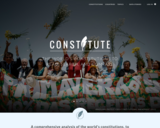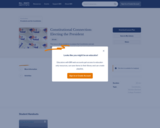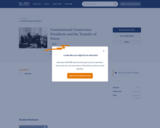
Together, the U.S. House of Representatives and U.S Senate are called Congress, the legislative branch of the federal government.
- Subject:
- History
- Material Type:
- Reading
- Provider:
- U.S. Capitol Visitor Center
- Date Added:
- 08/11/2022


Together, the U.S. House of Representatives and U.S Senate are called Congress, the legislative branch of the federal government.

In this activity (which is appropriate for introducing the Constitution) students match primary source documents to clauses from Article 1 of the Constitution. Students find six pairs, which reveal the powers of Congress. Online resource.

Congressional oversight is the power of the legislative branch to review, monitor and supervise the actions of the federal bureaucracy. This lesson provides an overview of this congressional power and how it is used to as a check on the executive branch. Students will apply their knowledge of congressional oversight to examples of congressional hearings.

In the Constitution, the Congress is given the sole power of impeachment and removing the President and all civil officers from office. This power of Legislative Branch provides a significant check over the Executive and Judicial Branches. This lesson provides explanations of the Constitutional basis of the power, the process for removing officials and the history of impeachments and removing these officials from office. It also provides discussions on the standards of impeachments and how those are interpreted by Congress.

The text of the United States Constitution translated into Spanish. The page does have advertisements as well, so it is best used as a teacher resource.

The world's constitutions to read, search, and compare

They met in Philadelphia in May 1787. Fifty-five men from 12 different states gathered, intending to revise the Articles of Confederation... Thus began the Constitutional Convention – the four-month process of secret argument, debate and compromise that produced a document that would soon be known in all corners of the globe: the Constitution of the United States. This primary source set includes documents and images. A teacher guide is included to assist educators in utilizing the primary sources in their instruction.

Students will learn how our Constitution was created and what some of its key characteristics are. They will also explore key amendments to the Constitution and their application in protecting citizens' rights.

15 asynchronous modules about the U.S. Constitution. Modules included videos, activites and student/teacher notes/instructions

This lesson has students use C-SPAN's Constitution Clips to explore the provisions of the U.S. Constitution. Using their own devices in class or at home, students will be introduced to the Constitution through C-SPAN video clips. This lesson has students complete an online scavenger hunt to learn more about the structure and rights included in the document. This scavenger hunt is best suited for classes with one-to-one devices or a flipped classroom format.

How do liberty and equality interact in the Constitution? On Friday, September 17th from 10:30 AM to 3:00 PM ET, the Bill of Rights Institute streamed this live event and welcomed scholars, thinkers, and teachers to explore the relevancy of the Constitution today. How can we work to balance liberty and equality in our communities? Where do tensions arise between the two principles, and what tools from the Constitution can we use to work toward resolution?

This lesson introduces students to important facts about the Constitution and its history. Students create a thirteen-star flag and read or perform the Constitution Day Rap.

Fifty-five delegates were present at the Constitutional Convention, which was held in Philadelphia in the summer of 1787. Most students can identify George Washington, James Madison, and maybe even Alexander Hamilton. But what about the other fifty-two delegates? Who were they? How did they influence the convention? In this lesson students will familiarize themselves with the delegates by listening to a series of 60-Second Civics podcast episodes devoted to the Framers of the Constitution.

This comprehensive series of 35 short videos explains the text, history, and relevance of the United States Constitution, Bill of Rights, and additional amendments in everyday language. Each video is assignable and ends with a call-to-action question, prompting learners to further explore the topics.

How is the Constitution structured? In this episode of our "Close Reads: Explained" series, Kirk tackles the Constitution and explains its biggest concepts to you. What does the document teach us about the government it defines?

Take the Constitution quiz to find out how much you know about the Constitution of the United States of America.

In this lesson, students develop an awareness of the Constitution by exploring what it is and why it is important. Students examine their classroom rules poster as an introduction to the concept of rules and learn that the Constitution is the law of the United States.

This lesson allows students to analyze the Constitution and ask questions about how the Constitution talks about presidential elections.

This lesson allows students to analyze the Constitution and ask questions about how the Constitution allows for impeachment of the President.

This lesson allows students to analyze the Constitution and ask questions about how the Constitution effects the transfer of power between presidents.